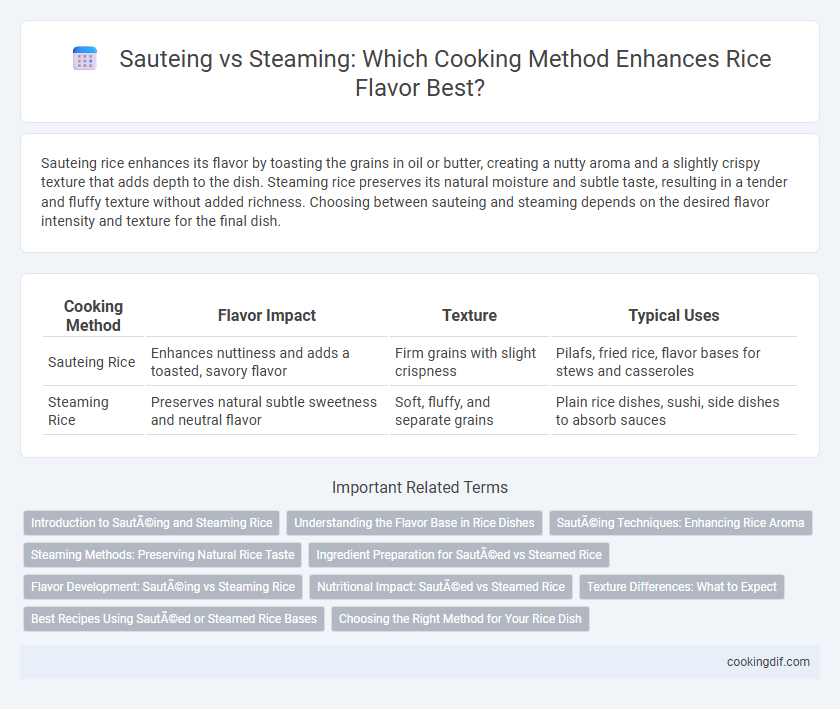Sauteing rice enhances its flavor by toasting the grains in oil or butter, creating a nutty aroma and a slightly crispy texture that adds depth to the dish. Steaming rice preserves its natural moisture and subtle taste, resulting in a tender and fluffy texture without added richness. Choosing between sauteing and steaming depends on the desired flavor intensity and texture for the final dish.
Table of Comparison
| Cooking Method | Flavor Impact | Texture | Typical Uses |
|---|---|---|---|
| Sauteing Rice | Enhances nuttiness and adds a toasted, savory flavor | Firm grains with slight crispness | Pilafs, fried rice, flavor bases for stews and casseroles |
| Steaming Rice | Preserves natural subtle sweetness and neutral flavor | Soft, fluffy, and separate grains | Plain rice dishes, sushi, side dishes to absorb sauces |
Introduction to Sautéing and Steaming Rice
Sauteing rice involves briefly frying grains in oil or butter to develop a nutty aroma and enhance the base flavor before adding liquid. Steaming rice, on the other hand, cooks grains using moist heat, preserving the natural texture and subtle sweetness. Both methods influence the rice's taste profile, with sauteing creating a richer, deeper flavor and steaming maintaining a lighter, fluffier consistency.
Understanding the Flavor Base in Rice Dishes
Sauteing rice enhances the flavor base by evenly toasting the grains and infusing them with aromatic oils and spices, creating a nutty, rich depth perfect for pilafs and biryanis. Steaming preserves the rice's natural, delicate flavor and maintains a fluffy texture, making it ideal for dishes where subtlety and purity of taste are desired, such as jasmine or basmati rice served alongside complex sauces. Understanding these techniques allows cooks to strategically layer flavors, balancing texture and aroma to elevate the overall dish.
Sautéing Techniques: Enhancing Rice Aroma
Sauteing rice in oil or butter unlocks nutty, toasted aromas that steaming alone cannot replicate, creating a richer flavor base. The Maillard reaction, triggered during sauteing, enhances the rice's natural sweetness and depth, which intensifies the overall dish profile. Incorporating aromatics like garlic, onions, or herbs during sauteing further amplifies the rice's fragrance and complexity.
Steaming Methods: Preserving Natural Rice Taste
Steaming rice preserves its natural flavor by cooking grains evenly with gentle heat and moisture, avoiding the oiliness associated with sauteing. This method maintains the rice's inherent nutty and slightly sweet taste while enhancing its fluffy, tender texture. Steamed rice also retains more nutrients and subtle aromas, providing a pure, clean base that complements a variety of dishes without overpowering them.
Ingredient Preparation for Sautéed vs Steamed Rice
Sauteing rice involves toasting grains in oil or butter, which enhances nutty flavors and creates a slightly crispy texture by coating each grain, resulting in a richer taste profile. Steaming rice preserves its natural aroma and moisture, yielding soft, fluffy grains that maintain a clean, delicate flavor ideal for absorbing sauces and spices. Proper ingredient preparation for sauteed rice includes rinsing to remove excess starch but drying grains thoroughly to avoid sogginess, whereas steamed rice benefits from rinsing and maintaining moisture equilibrium for even cooking.
Flavor Development: Sautéing vs Steaming Rice
Sauteing rice in oil or butter before cooking enhances flavor development through Maillard reactions, producing a nutty, toasted aroma that intensifies the dish's complexity. In contrast, steaming rice preserves its natural, subtle fragrance and delicate texture without introducing additional flavors. Choosing sauteing over steaming creates a richer, deeper flavor base ideal for pilafs and savory dishes.
Nutritional Impact: Sautéed vs Steamed Rice
Sauteed rice absorbs oils and seasonings, enhancing flavor complexity but increasing calorie and fat content compared to steamed rice. Steaming preserves more water-soluble vitamins and minerals like B vitamins and antioxidants due to minimal heat exposure and the absence of added fats. For a healthier nutritional profile, steaming rice retains essential nutrients and lowers fat intake, while sauteing offers richer taste at the cost of higher calories.
Texture Differences: What to Expect
Sauteing rice enhances its texture by creating a slightly toasted, nutty exterior that adds a subtle crunch to each bite. Steaming preserves the rice's natural moisture, resulting in a soft, fluffy texture that absorbs flavors evenly. Expect sauteed rice to have a firmer, more distinct grain structure, while steamed rice offers a tender, cohesive consistency ideal for dishes needing gentle blending of ingredients.
Best Recipes Using Sautéed or Steamed Rice Bases
Sauteed rice develops a nutty, caramelized flavor ideal for fried rice and pilaf, enhancing dishes like vegetable stir-fries and seafood bowls. Steamed rice retains a clean, fluffy texture perfect for sushi, biryanis, and curry accompaniments, allowing bold sauces and spices to shine. Recipes leveraging sauteed rice often layer flavors from garlic, onions, and spices, while steamed rice serves as a neutral base that highlights complementary ingredients and seasonings.
Choosing the Right Method for Your Rice Dish
Sauteing rice before cooking enhances its nutty flavor and creates a toasty aroma that deepens the overall taste profile, ideal for pilafs and risottos. Steaming preserves the rice's natural sweetness and texture, making it perfect for dishes requiring subtle, delicate flavors such as jasmine or basmati rice. Selecting the right method depends on the desired flavor intensity and the specific rice variety used, ensuring optimal taste and texture balance.
Sautéing vs steaming for flavor base Infographic

 cookingdif.com
cookingdif.com